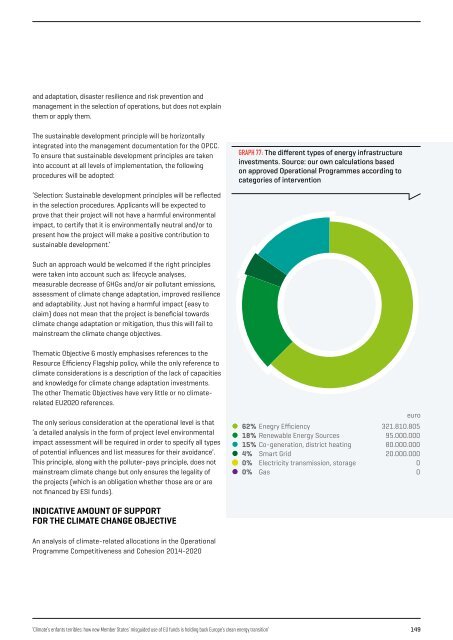ENFANTS TERRIBLES
enfants-terribles
enfants-terribles
You also want an ePaper? Increase the reach of your titles
YUMPU automatically turns print PDFs into web optimized ePapers that Google loves.
and adaptation, disaster resilience and risk prevention and<br />
management in the selection of operations, but does not explain<br />
them or apply them.<br />
The sustainable development principle will be horizontally<br />
integrated into the management documentation for the OPCC.<br />
To ensure that sustainable development principles are taken<br />
into account at all levels of implementation, the following<br />
procedures will be adopted:<br />
GRAPH 77: The different types of energy infrastructure<br />
investments. Source: our own calculations based<br />
on approved Operational Programmes according to<br />
categories of intervention<br />
‘Selection: Sustainable development principles will be reflected<br />
in the selection procedures. Applicants will be expected to<br />
prove that their project will not have a harmful environmental<br />
impact, to certify that it is environmentally neutral and/or to<br />
present how the project will make a positive contribution to<br />
sustainable development.’<br />
Such an approach would be welcomed if the right principles<br />
were taken into account such as: lifecycle analyses,<br />
measurable decrease of GHGs and/or air pollutant emissions,<br />
assessment of climate change adaptation, improved resilience<br />
and adaptability. Just not having a harmful impact (easy to<br />
claim) does not mean that the project is beneficial towards<br />
climate change adaptation or mitigation, thus this will fail to<br />
mainstream the climate change objectives.<br />
Thematic Objective 6 mostly emphasises references to the<br />
Resource Efficiency Flagship policy, while the only reference to<br />
climate considerations is a description of the lack of capacities<br />
and knowledge for climate change adaptation investments.<br />
The other Thematic Objectives have very little or no climaterelated<br />
EU2020 references.<br />
The only serious consideration at the operational level is that<br />
‘a detailed analysis in the form of project level environmental<br />
impact assessment will be required in order to specify all types<br />
of potential influences and list measures for their avoidance’.<br />
This principle, along with the polluter-pays principle, does not<br />
mainstream climate change but only ensures the legality of<br />
the projects (which is an obligation whether those are or are<br />
not financed by ESI funds).<br />
euro<br />
62% Enegry Efficiency 321.810.805<br />
18% Renewable Energy Sources 95.000.000<br />
15% Co-generation, district heating 80.000.000<br />
4% Smart Grid 20.000.000<br />
0% Electricity transmission, storage 0<br />
0% Gas 0<br />
INDICATIVE AMOUNT OF SUPPORT<br />
FOR THE CLIMATE CHANGE OBJECTIVE<br />
An analysis of climate-related allocations in the Operational<br />
Programme Competitiveness and Cohesion 2014-2020<br />
‘Climate’s enfants terribles: how new Member States’ misguided use of EU funds is holding back Europe’s clean energy transition’ 149


